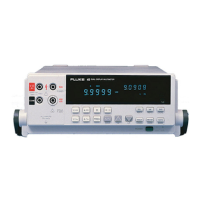45
Users Manual
2-6
Measuring Voltage, Resistance, or Frequency
To measure voltage, resistance, or frequency, press the desired function button and
connect the test leads as shown in Figure 2-5. The meter will select the appropriate range
in the autorange mode, and an annunciator on the display will indicate measurement
units.
Note
After measuring high voltage to 1000 V dc, errors may occur when making
measurements with 1 to 10 µV resolution. Allow up to two minutes prior to
making low-level measurements.
Measuring Current
To measure current, insert the test leads in the 100 mA input terminal for currents up to
100 mA or in the 10 A input terminal for higher current. Press C or D and connect
the test leads as shown in Figure 2-6 and described in the following procedure:
1. Turn off power in the circuit to be measured.
2. Break the circuit (on the ground side to minimize the common mode voltage), and
place the meter in series at that point. (To measure current without breaking the
circuit, use a current clamp.)
3. Turn on power to the circuit, and read the display. The meter will select the
appropriate range automatically, and an annunciator on the display will indicate the
units of the measurement value shown.
4. Turn off power to the circuit and disconnect the meter from the tested circuit.
Note
After measuring high current using the 10 A input, thermal voltages are
generated that may create errors when making low-level (high sensitivity)
dc measurements of volts, current, or ohms. To make the most accurate
measurements, allow up to ten minutes for the thermals to settle out.
Diode/Continuity Testing
Diode and continuity tests are performed by a diode test function with a continuity beeper
that can be turned on and off.
The continuity test determines whether a circuit is intact (i.e., has a resistance less than
about 30 Ω). The meter detects continuity for intervals as brief as 50 µs. The continuity
test function cannot be selected for the secondary display.
To perform a continuity test, press G , and connect the test leads as shown in Figure
2-7. The beeper emits a single beep when the input drops below +0.8 V (approximately
1 kΩ), and emits a continuous tone when the input goes below +25 mV (approximately
30 Ω).
The diode test measures the forward voltage of a semiconductor junction (or junctions) at
approximately 0.7 mA. Readings are displayed in the 3 V range at the medium and fast
measurement rates. "OL" is displayed for voltages above +2.5 V. If the diode test is
performed at the slow reading rate, readings are displayed in millivolts on the 1000 mV
(1 V) range.

